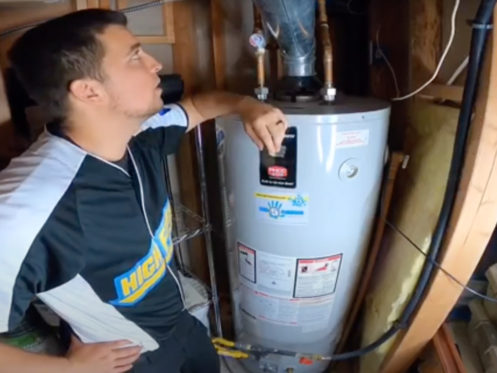Maintaining Your Home's Hot Water System: Key Tips
Maintaining Your Home's Hot Water System: Key Tips
Blog Article
What're your opinions about How to Maintain Your Water Heater & Prolong its Life?

Warm water is essential for day-to-day convenience, whether it's for a rejuvenating shower or washing recipes. To guarantee your warm water system runs effectively and lasts much longer, routine upkeep is crucial. This write-up supplies useful suggestions and understandings on just how to maintain your home's hot water system to prevent disturbances and costly repair work.
Introduction
Keeping your home's warm water system may seem daunting, yet with a few simple actions, you can ensure it runs smoothly for several years to come. This guide covers whatever from comprehending your warm water system to DIY maintenance tips and knowing when to call in specialist help.
Significance of Keeping Your Hot Water System
Normal upkeep not only prolongs the life-span of your hot water system but likewise ensures it operates efficiently. Disregarding maintenance can result in lowered performance, higher power costs, and even premature failing of the system.
Signs Your Warm Water System Requirements Maintenance
Understanding when your warm water system requires attention can prevent major concerns. Keep an eye out for signs such as irregular water temperature, odd noises from the heating unit, or rusty water.
Understanding Your Warm Water System
Prior to diving into upkeep jobs, it's handy to understand the standard parts of your hot water system. Commonly, this includes the water heater itself, pipelines, anode poles, and temperature level controls.
Monthly Maintenance Tasks
Normal monthly checks can assist catch minor concerns before they intensify.
Purging the Water Heater
Flushing your hot water heater eliminates sediment accumulation, improving performance and lengthening its life.
Monitoring and Changing Anode Rods
Anode poles protect against rust inside the storage tank. Evaluating and changing them when worn is vital.
Evaluating and Readjusting Temperature Setups
Adjusting the temperature level setups guarantees optimum efficiency and security.
Do It Yourself Tips for Maintenance
You can perform several upkeep tasks on your own to keep your hot water system in top condition.
Checking for Leaks
Regularly inspect pipes and connections for leaks, as these can cause water damages and greater costs.
Examining Pressure Alleviation Valves
Evaluating the pressure safety valve ensures it works correctly and avoids too much stress build-up.
Shielding Pipes
Insulating warm water pipelines decreases warmth loss and can save power.
When to Call an Expert
While DIY maintenance is advantageous, some issues need professional proficiency.
Complex Concerns Calling For Specialist Help
Examples consist of significant leakages, electric troubles, or if your water heater is regularly underperforming.
Regular Professional Maintenance Conveniences
Specialist upkeep can consist of detailed inspections, tune-ups, and guaranteeing conformity with safety requirements.
Final thought
Regular maintenance of your home's hot water system is vital for effectiveness, durability, and price financial savings. By complying with these tips and understanding when to seek professional assistance, you can make sure a trusted supply of hot water without unforeseen disturbances.
How to Maintain an Instant Hot Water Heater
Before tinkering with your hot water heater, make sure that it’s not powered on. You also have to turn off the main circuit breaker and shut off the main gas line to prevent accidents. Also turn off the water valves connected to your unit to prevent water from flowing into and out of the appliance. 2. When you’re done, you have to detach the purge valves’ caps. These look like the letter “T†and are situated on either side of the water valves. Doing so will release any pressure that has accumulated inside the valves while at the same time avoid hot water from shooting out and burning your skin. 3. When the purge valves’ caps are removed, you have to connect your hosing lines to the valves. Your unit should have come with three hoses but if it didn’t, you can purchase these things from any hardware or home repair shops. You can also get them from retail stores that sell water heating systems. Read the user’s manual and follow it to complete this task properly. When the hosing lines are connected, open the purge port’s valves. 4. You should never use harsh chemical cleaners or solutions when cleaning your unit. Make use of white vinegar instead. It should be undiluted and you’ll probably use about 2 gallons. 5. Now flush your water heater. This task should probably take about 40 minutes. We can’t give you specific directions for this because the procedure is carried out depending on the type, model and brand of your heater. With that being said, refer to the user’s manual. 6. When you’re done draining the unit, you have to turn off the purge port valves again. Remove the hosing lines that you earlier installed on each of the water valves. Put the valve caps (purge port) back in their respective places and be very careful so as not to damage the rubber discs that are found inside these caps. 7. Now that everything’s back in place, check your user’s manual again to find out how to reactivate your water heating system. 8. Once it is working, turn one of your hot water faucets on just to let air pass through the heater’s water supply pipes. Leave the tap on until water flows smoothly out of it. https://www.orrplumbing.com/blog/2014/september/how-to-maintain-an-instant-hot-water-heater/

Hopefully you enjoyed reading our part about How to Maintain Your Water Heater & Prolong its Life. Many thanks for finding the time to read through our blog. Appreciated our content? Please share it. Help other people discover it. Kudos for your time. Kindly come by our site back soon.
Browse Our Site Report this page